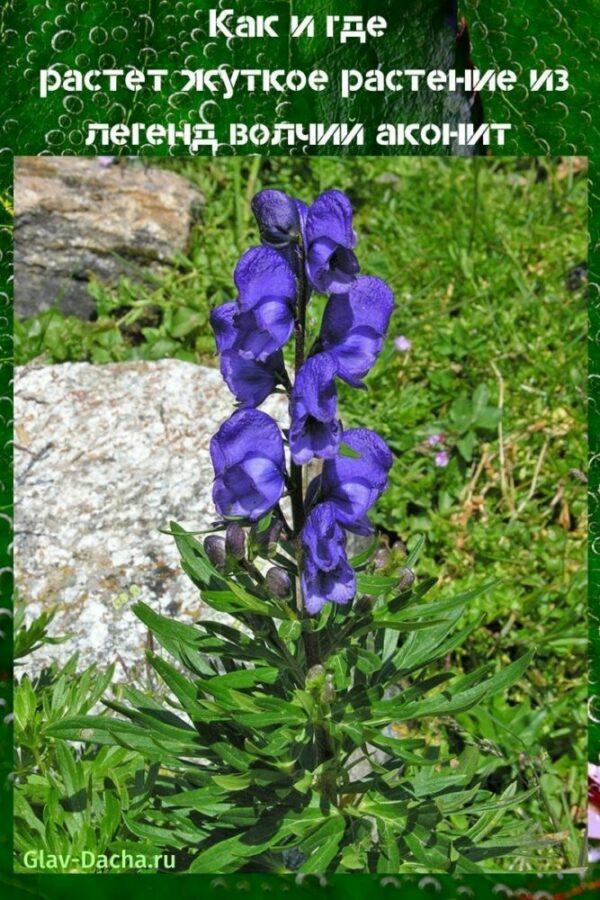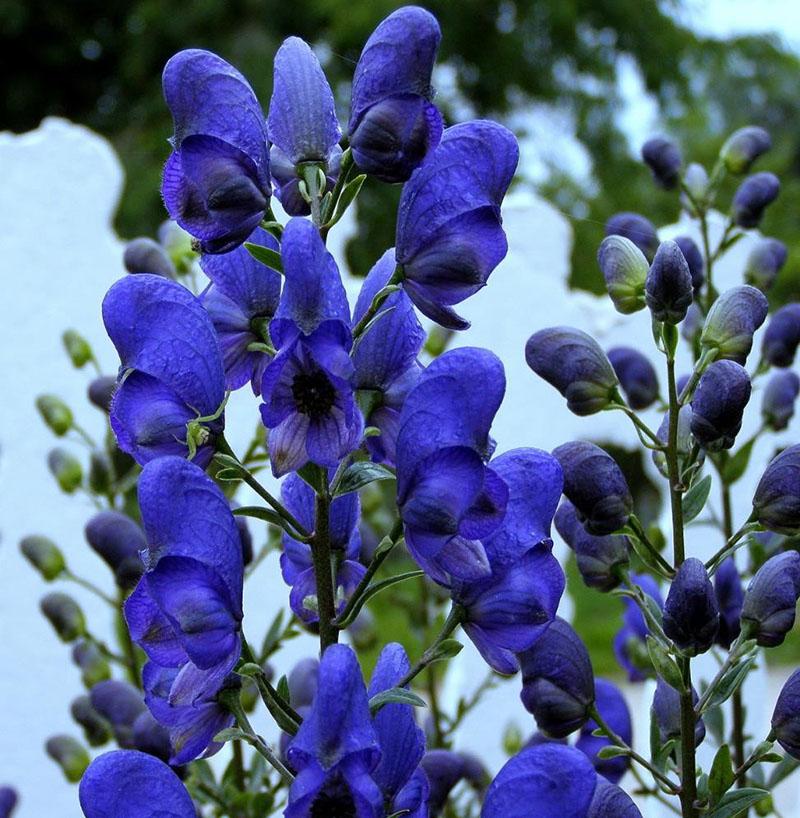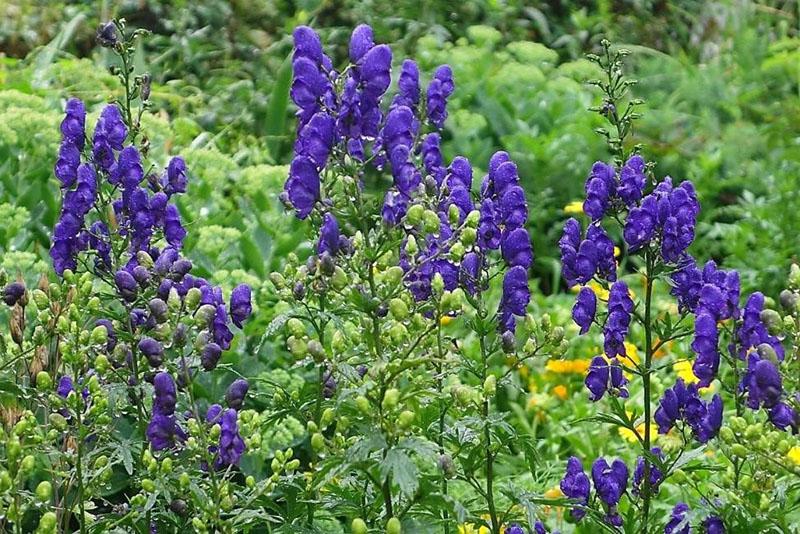How and where does the eerie plant from the legends grow wolf aconite
 Few gardeners and villagers know where wolf aconite grows and what properties the plant has. Although, perhaps, they have heard of her as a wolf-fighter, a root-fighter, a goat's death or a lumbago-grass. Such popular opinion does not bode well, the plant is considered poisonous.
Few gardeners and villagers know where wolf aconite grows and what properties the plant has. Although, perhaps, they have heard of her as a wolf-fighter, a root-fighter, a goat's death or a lumbago-grass. Such popular opinion does not bode well, the plant is considered poisonous.
What is aconite, what does it look like

Wolf aconite has two types of root system:
- Tuber roots, which over time form a whole system of 12-15 roots, elongated in a chain, or single tuber roots, annually dying off together with the ground part.
- Taproot composed of many thin, cord-like, tightly intertwined roots.
The height of aconite can reach 1 m. Its leaves are very rich green, rounded, palmate. The apical raceme consists of flowers with a five-leafed calyx, which can be yellow, blue, white or lilac. It begins to bloom in mid-July and ends in October. The fruits are dry leaflets.
Bees collect small amounts of nectar and pollen from aconite flowers. But only if there are no other flowering plants in the area. Aconites can poison them.
How dangerous is wolf root
 The appearance on Earth of aconite is associated with one of the ancient Greek myths about Hercules. The great warrior brought from the underworld the hellish dog Cerberus, from whose poisonous saliva a black root was born. This indicates that a few thousand years ago people knew that the plant is poisonous, it cannot be used in any form. In the legends of Scandinavia, the wrestler (aconite) grew up where Thor slain a poisonous snake, but he himself died from its bites.
The appearance on Earth of aconite is associated with one of the ancient Greek myths about Hercules. The great warrior brought from the underworld the hellish dog Cerberus, from whose poisonous saliva a black root was born. This indicates that a few thousand years ago people knew that the plant is poisonous, it cannot be used in any form. In the legends of Scandinavia, the wrestler (aconite) grew up where Thor slain a poisonous snake, but he himself died from its bites.
 The fact that aconite is poisonous has not raised doubts for a long time. In Nepal, bait and water were poisoned in sources from which predatory animals drank, or enemies could quench their thirst. In China and Greece, with great care, they made poison for arrows from aconite, poison for wolves. No wonder the ancients argued that not only the whole plant is poisonous, even its smell is poisonous.
The fact that aconite is poisonous has not raised doubts for a long time. In Nepal, bait and water were poisoned in sources from which predatory animals drank, or enemies could quench their thirst. In China and Greece, with great care, they made poison for arrows from aconite, poison for wolves. No wonder the ancients argued that not only the whole plant is poisonous, even its smell is poisonous.
A freshly cut plant is especially poisonous. The toxic alkoloid aconitine is found in any part of the plant, even in pollen, but it is especially abundant in the roots and seeds.
The symptoms of poisoning are as follows:
- rapid numbness of the tongue and mouth, tingling sensation;
- shortness of breath, other breathing disorders;
- weak, gradually increasing pulse, arrhythmia;
- dizziness, a state of stunnedness;
- drooling, nausea, and vomiting;
- clammy, very cold skin;
- pulmonary edema, convulsions.
After paralysis of the respiratory center, death occurs. Therefore, even with a slight suspicion of aconite poisoning, it is necessary to urgently call an ambulance, and before its arrival, act according to the instructions given by the dispatcher or the doctor on duty.
Where does wolf aconite grow
 An unpretentious plant common in the Asian region, Europe, North America. Occurs along river banks, in alpine meadows, along roads. Often chooses nutritious soils with a high content of humus. It can be seen both on rocky slopes and near mountain rivers, in the tundra.
An unpretentious plant common in the Asian region, Europe, North America. Occurs along river banks, in alpine meadows, along roads. Often chooses nutritious soils with a high content of humus. It can be seen both on rocky slopes and near mountain rivers, in the tundra.
In the northern hemisphere, 330 plant species belong to the genus wrestler. In the European part of Russia, 4 types of aconite grow in natural conditions, all of them are quite poisonous.
Antidote fighter (oak)
 It grows mainly in the chernozem zone, on forest edges, flooded and dry meadows, in deciduous forests and shrubs. It differs from other species in light yellow flowers. It is found in the Crimea, Ukraine, the Caucasus and Altai, and is common in Western and Eastern Siberia.
It grows mainly in the chernozem zone, on forest edges, flooded and dry meadows, in deciduous forests and shrubs. It differs from other species in light yellow flowers. It is found in the Crimea, Ukraine, the Caucasus and Altai, and is common in Western and Eastern Siberia.
Its chemical composition is very different from that of other plants of this genus. According to the information provided by Academician A.P. Orekhov, in the aerial part of the plant there are two alkaloids - antorin and pseudoantorin. Non-poisonous roots. In their composition, another, special alkoloid was found, resembling atisine in structure, an antagonist of aconitines. The plant, especially the roots, is used in folk medicine and homeopathy. Used as an insecticide to kill raspberry beetle and rape beetle. The antidote fighter has decorative shapes and varieties.
Northern wrestler (high)
 It grows in China, Europe, Asia, Siberia, the European part of the Russian Federation, especially in the northern regions and forests of the North-Eastern Altai. It is found not only among trees, but also in dense thickets shrubs... The flowers are grayish-purple, of different tonal saturation. Their upper part is more elongated than that of other species. The plant is listed in the Red Data Books of many regions and regions of Russia.
It grows in China, Europe, Asia, Siberia, the European part of the Russian Federation, especially in the northern regions and forests of the North-Eastern Altai. It is found not only among trees, but also in dense thickets shrubs... The flowers are grayish-purple, of different tonal saturation. Their upper part is more elongated than that of other species. The plant is listed in the Red Data Books of many regions and regions of Russia.
The stem of the northern fighter reaches 2–2.5 m. The roots and grass of the plant are used in folk medicine in Tibet, Mongolia, Siberia and Altai. However, it is considered poisonous to animals in any form. In Altai, it was previously used to fight flies and cockroaches. Some cattle breeders in Mongolia poison predators with a powder from the root of a tall fighter, mixed with the blood of animals.
The cultural forms of the northern fighter are grown in the shade and partial shade. They do not tolerate transplanting well, so they should be immediately planted in a permanent place.
Woolly fighter

This plant can be found in some places in the European part of Russia. Endemic, therefore, where the wolf aconite of this species grows is difficult to say. But sometimes it can be seen in the forest or on a clearing. The stem reaches a height of 1.5 m, it is quite large and slightly ribbed at the base. The length of the petioles of the basal leaves is from 10 to 25 cm. The petioles of the stem leaves are very short. The inflorescence, with large, light yellow flowers, is a rather dense raceme about 30 cm long, which can branch below.
Baikal wrestler
 A perennial, growing in Transbaikalia, Eastern Siberia, Mongolia and China. Most of the plants are in the forest zone, as well as in the steppes, valleys, meadows. The stem height does not exceed 1 m, most often it is short, about 40 cm. The rhizome consists of two elongated tubers. The flowers are bright blue, each 3 cm long.
A perennial, growing in Transbaikalia, Eastern Siberia, Mongolia and China. Most of the plants are in the forest zone, as well as in the steppes, valleys, meadows. The stem height does not exceed 1 m, most often it is short, about 40 cm. The rhizome consists of two elongated tubers. The flowers are bright blue, each 3 cm long.
Flerov's wrestler
 A very rare species, therefore the area where this type of wolf aconite grows is very small. Distributed in the basin of the Sherna River, flowing through the territory of the Vladimirovsk region. It is a narrowly local endemic, listed in the Red Book of the Russian Federation. Occurs in swampy areas, floodplain meadows, valleys of small rivers. The flowers are deep purple, with a cylindrical helmet.
A very rare species, therefore the area where this type of wolf aconite grows is very small. Distributed in the basin of the Sherna River, flowing through the territory of the Vladimirovsk region. It is a narrowly local endemic, listed in the Red Book of the Russian Federation. Occurs in swampy areas, floodplain meadows, valleys of small rivers. The flowers are deep purple, with a cylindrical helmet.